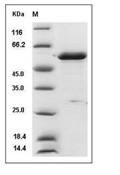 Your shopping cart is currently empty
Your shopping cart is currently empty
PHGDH Protein, Human, Recombinant (His)
PHGDH is a member of the D-isomer specific 2-hydroxyacid dehydrogenase family. This new family consists of D-isomer-stereospecific enzymes. The conserved residues in this family appear to be the residues involved in the substrate binding and the catalytic reaction, and thus to be targets for site-directed mutagenesis. A number of NAD-dependent 2-hydroxyacid dehydrogenases which seem to be specific for the D-isomer of their substrate have been shown to be functionally and structurally related. PHGDH catalyzes the transition of 3-phosphoglycerate into 3-phosphohydroxypyruvate, which is the first and rate-limiting step in the phosphorylated pathway of serine biosynthesis, using NAD+/NADH as a cofactor. Overexpression of PHGDH may cause certain breast cancers. Defects in PHGDH are the cause of phosphoglycerate dehydrogenase deficiency which is characterized by congenital microcephaly, psychomotor retardation, and seizures.

PHGDH Protein, Human, Recombinant (His)
| Pack Size | Price | USA Warehouse | Global Warehouse | Quantity |
|---|---|---|---|---|
| 5 μg | $52 | - | In Stock | |
| 10 μg | $82 | 7-10 days | 7-10 days | |
| 20 μg | $132 | 7-10 days | 7-10 days | |
| 50 μg | $256 | 7-10 days | 7-10 days | |
| 100 μg | $428 | 7-10 days | 7-10 days | |
| 200 μg | $731 | 7-10 days | 7-10 days | |
| 500 μg | $1,480 | 7-10 days | 7-10 days |
Product Information
| Biological Activity | Activity testing is in progress. It is theoretically active, but we cannot guarantee it. If you require protein activity, we recommend choosing the eukaryotic expression version first. |
| Description | PHGDH is a member of the D-isomer specific 2-hydroxyacid dehydrogenase family. This new family consists of D-isomer-stereospecific enzymes. The conserved residues in this family appear to be the residues involved in the substrate binding and the catalytic reaction, and thus to be targets for site-directed mutagenesis. A number of NAD-dependent 2-hydroxyacid dehydrogenases which seem to be specific for the D-isomer of their substrate have been shown to be functionally and structurally related. PHGDH catalyzes the transition of 3-phosphoglycerate into 3-phosphohydroxypyruvate, which is the first and rate-limiting step in the phosphorylated pathway of serine biosynthesis, using NAD+/NADH as a cofactor. Overexpression of PHGDH may cause certain breast cancers. Defects in PHGDH are the cause of phosphoglycerate dehydrogenase deficiency which is characterized by congenital microcephaly, psychomotor retardation, and seizures. |
| Species | Human |
| Expression System | E. coli |
| Tag | C-His |
| Accession Number | O43175 |
| Synonyms | SERA,phosphoglycerate dehydrogenase,PHGDHD,PGDH,PGD,PGAD,PDG,NLS1,NLS,HEL-S-113,3-PGDH,3PGDH |
| Construction | A DNA sequence encoding the mature form of human PHGDH (O43175) (Met 1-Phe 533) was fused with a polyhistidine tag at the C-terminus and an initial Met at the N-terminus. Predicted N terminal: Met |
| Protein Purity | > 90 % as determined by SDS-PAGE  |
| Molecular Weight | 58kDa (predicted); 55 kDa (reducing conditions) |
| Endotoxin | Please contact us for more information. |
| Formulation | Supplied as sterile PBS, 100 mM Arg, 0.1% Tween20, 20% glycerol, pH 8.0. |
| Reconstitution | A Certificate of Analysis (CoA) containing reconstitution instructions is included with the products. Please refer to the CoA for detailed information. |
| Stability & Storage | It is recommended to store the product under sterile conditions at -20°C to -80°C. Samples are stable for up to 12 months. Please avoid multiple freeze-thaw cycles and store products in aliquots. |
| Shipping | Shipping with blue ice. |
| Research Background | PHGDH is a member of the D-isomer specific 2-hydroxyacid dehydrogenase family. This new family consists of D-isomer-stereospecific enzymes. The conserved residues in this family appear to be the residues involved in the substrate binding and the catalytic reaction, and thus to be targets for site-directed mutagenesis. A number of NAD-dependent 2-hydroxyacid dehydrogenases which seem to be specific for the D-isomer of their substrate have been shown to be functionally and structurally related. PHGDH catalyzes the transition of 3-phosphoglycerate into 3-phosphohydroxypyruvate, which is the first and rate-limiting step in the phosphorylated pathway of serine biosynthesis, using NAD+/NADH as a cofactor. Overexpression of PHGDH may cause certain breast cancers. Defects in PHGDH are the cause of phosphoglycerate dehydrogenase deficiency which is characterized by congenital microcephaly, psychomotor retardation, and seizures. |
Dose Conversion
Calculator
Tech Support
| Size | Quantity | Unit Price | Amount | Operation |
|---|

Copyright © 2015-2026 TargetMol Chemicals Inc. All Rights Reserved.



